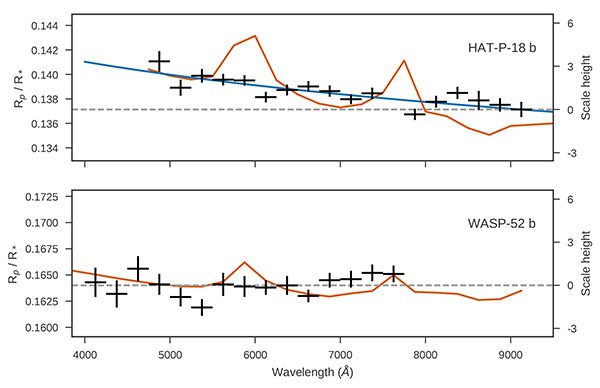ING web news release
28 August, 2017
Transmission Spectroscopy of Hot Jupiters Reveals Contrasting Atmospheres
A team of researchers led from the University of Warwick, UK is undertaking
a transmission spectroscopy survey of hot Jupiters using the ACAM imager and spectrograph
on the William Herschel Telescope (WHT). By
observing spectroscopically an exoplanet's transit across the face of its host star the
team is able to detect changes in opacity in the exoplanet's atmosphere
as a function of wavelength.
HAT-P-18b was the first result from this programme, and the second discovery of a Rayleigh
scattering slope in a hot Jupiter atmosphere from the ground (see figure below).
The authors found this
transmission spectrum was best represented by a Rayleigh slope at the
equilibrium temperature of the planet (blue line), which was
significantly favoured over a clear atmosphere model (orange line) due to
the absence of broad sodium and potassium absorption. They concluded
that a high altitude haze was likely present in the upper atmosphere,
masking the alkali metal features while giving rise to the slope seen.
A second hot Jupiter studied in this programme, WASP-52b, revealed
a spectrum significantly different to that found for HAT-P-18b. As
can be seen clearly in the figure below, the transmission spectrum (black error bars) is featureless,
consistent with a cloud layer at 0.1mbar. With a temperature of 1300 K,
WASP-52b is much hotter than HAT-P-18b, which has an equilibrium
temperature of only 850 K. At these kinds of temperatures, it is
possible that the clouds that mask the features are formed of some kind
of silicate vapour.
WASP-52b is similar to the well studied hot Jupiter HD
189733b, but lacks the significant Rayleigh scattering slope that has
been observed on HD 189733b, meaning exoplanet atmospheres are more
diverse than was expected.
|
 |
The black error bars show the transmission spectra of HAT-P-18b and WASP-52b at a resolution of 250 angstroms, resulting from the fitting
of the high-quality ACAM light curves. The orange lines are clear atmosphere models and the blue line in the top panel is a Rayleigh scattering slope at the equilibrium temperature of the planet. See accompanying text for an explanation.
Large format: PNG. |
These early results have demonstrated the capabilities of ACAM to
detect atmospheric opacity sources such as Rayleigh scattering, and to
distinguish between clear and cloudy atmospheres with errors in the
transmission spectrum of around 1 atmospheric scale height, comparable
to Hubble Space Telescope.
Transmission spectroscopy is revealing a startling diversity in the
atmospheres of hot Jupiters with some clear, some cloudy, such as
WASP-52b, and some dominated by condensate hazes, like in HAT-P-18b. In
the limited sample of systems studied to date, no clear correlations
have emerged between the properties of the atmosphere and key parameters
such as temperature and surface gravity, and measurements of a wider
sample of planets are needed.
More information:
J. Kirk, P. J. Wheatley, T. Louden, S. P. Littlefair, C. M. Copperwheat, D. J. Armstrong, T. R. Marsh, V. S. Dhillon, 2016, "Transmission spectroscopy of the inflated exoplanet WASP-52b, and evidence for a bright region on the stellar surface", MNRAS, 463, 2922 [ ADS ].
J. Kirk, P. J. Wheatley, T. Louden, A. P. Doyle, I. Skillen, J. McCormac, P. G. J. Irwin, R. Karjalainen, 2017, "Rayleigh scattering in the transmission spectrum of HAT-P-18b", MNRAS, 468, 3907 [ ADS ].
T. Louden, P. J. Wheatley, P. G. J. Irwin, J. Kirk, I. Skillen, 2017, "A precise optical transmission spectrum of the inflated exoplanet WASP-52b", MNRAS, 470, 742 [ ADS ].
|
|



